MEDIUM
Earn 100
Three small conducting spheres each of radius and charge is placed at the corners of an equilateral triangle of side length . The side length is considerably large than the dimensions of the spheres. Find the electrical potential energy of the system.
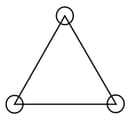
(a).
(b).
(c).
(d)None of these.
50% studentsanswered this correctly
Important Questions on Electrostatic Potential and Capacitance
HARD
The work done to assemble the three charges in a configuration as shown in the figure below is
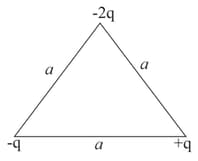
MEDIUM
A two point charges and are fixed on the -axis at and , respectively. If the third point charge ‘ ’ is taken from the origin to along the semicircle as shown in the figure, the energy of the charge will:
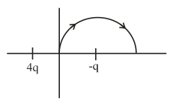
EASY
The kinetic energy of an electron which is accelerated through a potential difference of will be ___ .
MEDIUM
The charges , and are placed at equal distances along a straight line. If the total P.E. of the system is zero, the ratio becomes,
EASY
The diagrams below show regions of equipotential.

A positive charge is moved from to in each diagram.
HARD
Four identical point masses, each of mass and carrying charge are placed at the corners of a square of sides on a frictionless plane surface. If the particles are released simultaneously, the kinetic energy of the system when they are infinitely far apart is
MEDIUM
A point charge is rotated along a circle in the electric field generated by another point charge . The work done by the electric field on the rotating charge in one complete revolution is
HARD
Consider a sphere of radius with uniform charged density and total charge The electrostatic potential distribution inside the sphere is given by
Note that the zero of potential is at infinity. The values of are:
MEDIUM
A system of three charges are placed as shown in the figure:

If the potential energy of the system is best given by:
HARD
A charged particle of mass and charge moving under the influence of uniform electric field and a uniform magnetic field follows a trajectory from point to as shown in figure. The velocities at and are respectively, and . Then which of the following statements (A, B, C, D) are the correct? (Trajectory shown is schematic and not to scale)
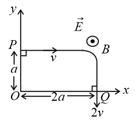
Rate of work done by the electric field at P is
Rate of work done by both the fields at Q is zero
The difference between the magnitude of angular momentum of the particle at P and Q is .
HARD
Four equal point charges each are placed in the plane at and . The work required to put a fifth charge at the origin of the coordinate system will be:
MEDIUM
Two equal charges of magnitude each are placed at a distance apart. Their electrostatic energy is third charge is brought midway between these two charges. The electrostatic energy of the system is now?
EASY
A particle has charge and particle has charge each of them having the same mass . When allowed to fall from rest through the same electrical potential difference, the ratio of their speeds will become
MEDIUM
Three point charges of each are kept at the vertices of an equilateral triangle of side If the system is supplied energy at the rate of the time taken to move one of the charges to the mid point of the line joining the other two charges is
HARD
A proton and an antiproton come close to each other in vacuum such that the distance between them is Consider the potential energy to be zero at infinity. The velocity at this distance will be:
EASY
What is the ratio of their final velocity when an alpha particle and a proton are accelerated at the same potential difference from the rest?
EASY
Consider a system of electrons. Upon exchange of a pair of electrons, the Coulomb potential of the system
EASY
A system of two charges separated by a certain distance apart stores electrical potential energy. If the distance between them is increased, the potential energy of the system,
HARD
A point particle of mass is moving along the -axis under a force described by the potential energy shown below. It is projected towards the right from the origin with a speed .
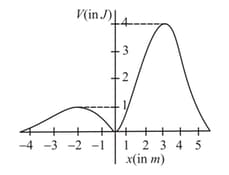
What is the minimum value of for which the particle will escape infinitely far away from the origin?
MEDIUM
When an -particle of mass moving with a undefined velocity bombards on a heavy nucleus of charge , its distance of the closest approach from the nucleus depends on as:

